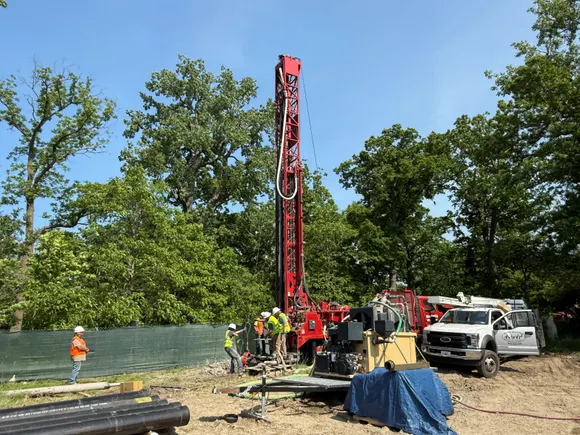Dive Brief:
- A novel geothermal heating and cooling system will keep approximately 68,000 square feet of building space comfortable while significantly reducing energy costs at a 130-year-old elementary school in the Chicago suburbs, Trane Technologies said June 30.
- The dynamic closed loop geothermal system in Highland Park, Illinois, which taps “the superior heat transfer properties of flowing water,” has a much smaller surface footprint than some other geothermal designs, making it ideal for suburban schools, Trane says.
- North Shore School District 112 combined local, state and federal incentives to offset as much as 50% of the $6.7 million project cost. The system should reduce the facility’s carbon emissions by about 30% while trimming operations and maintenance costs, Trane says.
Dive Insight:
Education institutions are increasingly interested in geothermal systems, with colleges and universities from Colorado to Vermont studying or actively building infrastructure to more efficiently heat and cool campus buildings.
North Shore School District 112’s DCL system at Ravinia Elementary School is the first of its kind to be deployed in the United States, Trane says.
DCL systems absorb and reject heat into subsurface water. That water’s depth and flow rate varies from place to place, thus any facility owner considering a DCL system should conduct a geological study to confirm that the local resource is adequate, Trane Technologies Turnkey Project Developer Andy O’Fallon said in an email.
If it’s not, traditional dry-rock geothermal could be more cost-effective. But those systems typically require more boreholes and have a larger physical footprint.
“The decision to pursue either option depends primarily on the available land area and hydrogeology,” O’Fallon said. “This site does not have land area to accommodate the traditional geothermal option.”
Whereas a similarly sized traditional geothermal system might need 50 wells, the system at Ravinia has just three wells drilled down 10-inch boreholes, O’Fallon said. If the aquifer’s flow rates match “the ideal predicted design,” each well could produce up to 150 tons of cooling and 50 tons of heating at full capacity, O’Fallon added.
Above ground, the system has more than 50 water-source heat pumps, plus a single-cell cooling tower for backup cooling and an electric boiler for backup heating if needed. The heat pumps exchange thermal energy with a building water loop that runs between 40 degrees and 90 degrees Fahrenheit, O’Fallon said.
The school district already had a working relationship with Trane, which helped overcome officials’ initial hesitation about deploying an unfamiliar technology, James Bock, the district’s director of operations, facilities and transportation, says in a video describing the project.
“We knew, because of our relationship with Trane, [that] they were bringing us something that was definitely worth taking a look at,” he said.
School District 112 deployed the DCL system as part of a bigger renovation project, according to O’Fallon. Other district facilities have had retrofits to improve their sustainability recently, including roof-mounted solar panels and building automation upgrades, he added.
Trane worked with the district’s accounting firm to provide technical documentation it needed to support its application for federal clean energy tax credits, O’Fallon added.
The “One Big Beautiful Bill Act” President Trump signed on July 4 significantly shortens the eligibility window for those credits and adds new restrictions that experts say could make them all but impossible to qualify for.
View the original article and our Inspiration here


Leave a Reply